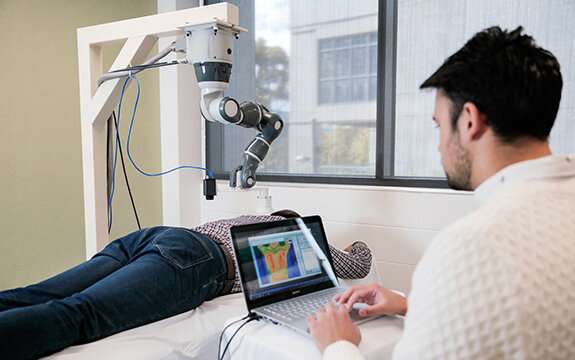Training robots to relieve chronic pain

Researchers at Swinburne have developed a collaborative robot system to automatically treat back, neck and head pain caused by soft tissue injury.
Based on an analysis of the patient by a thermal camera, the system uses a collaborative robot to apply targeted laser therapy to identified pain 'hot spots."
"Unlike conventional industrial robots that operate in a cage, collaborative robots are designed to work alongside people," says Senior Lecturer at Swinburne, Dr. Mats Isaksson, who led the project.
"They are power and speed limited so they can collide with people without causing harm."
In conjunction with industry partner IR Robotics, the focus of Dr. Isaksson's project was to develop an automatic solution for safe robotic examination and treatment of patients with chronic pain.
"Using the same technology used in cricket to show whether the ball has made contact with the bat, a thermal camera scans the patient and locates injuries and inflammation by identifying hot spots in a thermal image," Dr. Isaksson says.
"The location of the hot spot is then sent to the collaborative robot that moves a low-level infrared laser into contact with the patient to perform treatment."
The project has delivered a fully working prototype for automated photobiomodulation (PBM) therapy for chronic pain. This is a form of therapy that applies low-level lasers or light emitting diodes to the surface of the body to stimulate and heal soft tissue.
"Studies have shown PBM therapy to have positive effects on chronic pain symptoms," says Dr. Mark Rogers, a co-founder of IR Robotics and one of the Australian pioneers of PBM therapy.
"Introducing collaborative robots to deliver treatment has the potential to improve the precision of the therapy in addition to reducing costs involved. Building on Industry 4.0 technologies and big data analysis, the derived platform can self-adapt to provide individually optimal treatment."
Provided by Swinburne University of Technology




















